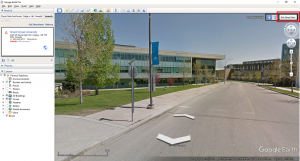

- #Change google earth pro for mac scale to meters how to
- #Change google earth pro for mac scale to meters manual
- #Change google earth pro for mac scale to meters code
fixing issue with svg file (not opening) Visit my other projects at urgr8.ch and Living in Natural Harmony. Created by Christoph Hofstetter (christophhofstetter (at) ) September 2013 v0.311 Resources: This script uses the Google Elevation API, Google Maps, jQuery and the CONREC contouring algorithm by Paul Bourke and Jason Davies. No warranty whatsoever is given, including but not limited to functioning or correctness. This script was developed with the Firefox browser and may not work in other browsers.
#Change google earth pro for mac scale to meters manual
Use the manual saving text areas below alternatively. You can save some data in cookies, however there is a limit. You can also change the number of contours or set custom contour values.

However, if you go beyond 2500 total samples per day, querying data may stop working according to the Google Elevation API description. Optionally you can change the number of elevation samples you want in each direction, the more the better. Java is a registered trademark of Oracle and/or its affiliates.Go to the desired location in the map, set two markers by clicking the map to define a rectangle (or enter coordinates manually). For details, see the Google Developers Site Policies.
#Change google earth pro for mac scale to meters code
If not over water, the altitude will be measured from the ground level.Įxcept as otherwise noted, the content of this page is licensed under the Creative Commons Attribution 4.0 License, and code samples are licensed under the Apache 2.0 License. Meaures the altitude from the sea floor directly below the feature, if the feature is placed over a major body of water. If each pole is 20m tall, the location of each pole's top will move up and down with the elevation of the Earth. Measures the altitude from the ground level directly below the coordinates.Īs an example, this altitude mode can be used to place the tops of powerline poles as they climb up and over a hill. It places the feature on the bottom of any major body of water if the feature is located away from a body of water, the feature will be clamped to the ground level, instead. See SeaFloor altitude modes and the KML extension namespace for important information.Īs with clampToGround, this mode ignores the altitude value. If the feature is positioned over a major body of water, clampToGround will place the feature at sea level.Īny KML feature with no altitude mode specified will default to clampToGround.Ĭontained within the extension namespace. In this way, GroundOverlays can, for example, be 'draped' over the surface of the Earth. This mode ignores any altitude value, and places the KML feature on the surface of the ground, following the terrain. GPS tracks, for example, can use the absolute altitude mode to display paths created while flying or diving. This altitude mode is useful in situations where the altitude value is known precisely. Negative values are accepted, to place features below sea level. Portions of a feature can extend underground, as in the example below. In this way, features can be placed underground, and will not be visible. The absolute altitude mode measures altitude relative to sea level, regardless of the actual elevation of the terrain beneath the feature. Note that the gx-prefixed extension namespace may not be supported by all geo-browsers.

Then, substitute for when using either clampToSeaFloor or relativeToSeaFloor. To use them, you must first add the correct namespace URI to the opening element in your KML file: Sea floor-related altitude modes are contained within a set of extensions to the KML standard, using the gx prefix. It can also be ignored ( clampToGround and clampToSeaFloor) SeaFloor altitude modes and the KML extension namespace from the bottom of major bodies of water ( relativeToSeaFloor).from the surface of the Earth ( relativeToGround),.
#Change google earth pro for mac scale to meters how to
elements also can contain altitude.Īny altitude value should be accompanied by an element, which tells Google Earth how to read the altitude value. Many KML features can contain an element or coordinate, which specifies a distance above the ground level, sea level, or sea floor for that particular feature.


 0 kommentar(er)
0 kommentar(er)
